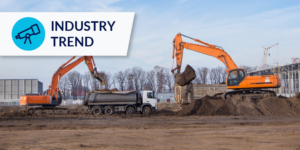
Despite some economic discord — and a predicted incoming cooldown in residential construction after a boom period — the heavy construction industry is forecast to grow by $46.09 billion in less than five years.
Gaining momentum throughout the next few years, the heavy construction industry, currently valued at $176 billion, is projected to reach a market value of $273 billion by 2030. Many are predicting this jump could be due to legislation like President Biden’s Build Back Better initiative.
Meet movers and shakers in heavy construction: The 10 Biggest Excavation and Foundation Contractors in the U.S. in 2022
The Build Back Better bill will spur this growth with various investments in 5G communications networks, green energy production, and repairing over 45,000 bridges across the U.S. Around 1 billion dollars is contained within this bill for such projects.
Meanwhile, the residential housing market is predicted to suffer a much more drastic cooldown as housing starts for single-family homes dropped 19% for the year this past September.
Along with this, building permits fell by 17% and construction cancellations rose to 24% from 15% since the second quarter of 2022. Fears of a possible recession and its effects on the housing market could continue to have lasting effects on residential construction.
Heavy construction could still face hurdles in its path
Despite upward trends in the heavy construction industry and the passage of the Infrastructure bill, many factors complicate the growth of this market, as well as others like telecommunications, and transmission and power.
Rising inflation, worker availability, supply chain delays, as well as very high demand for upgraded bridges and 5G communication networks are big problems for companies in these markets like EMCOR, Dycom, and MasTec.
The current infrastructure bill includes details stipulating that these projects must use American-made materials like steel and iron for such projects. Mitch Landrieu, Biden’s infrastructure coordinator, says it wouldn’t be reasonable to expect state and local officials to completely “turn on a dime” and that the administration would try to be flexible by evaluating waivers on a case-by-case basis.
Learn more: USDOT Waives ‘Buy America’ Requirements for Construction Materials — For Now
The heavy construction industry is driven by equipment rentals and the use of heavy-duty trucks to move materials. These new rules and the difficulty to get waivers on these material restrictions can potentially set back the industry in the short term.
Additionally, Asian markets, driven by the need to urbanize more rural areas, are actively seeking rentals and second-hand equipment to meet this demand as well as set aside losses from the COVID-19 pandemic.
Similar trends are happening stateside as water systems, communications towers, and various electrical projects will need to be handled by heavy construction companies like Emcor Group.
EMCOR group is expected to have earnings increases of 9.8% in 2022 and 13.7% in 2023 due to these trends.
Building for 5G and telecommunications can be key for heavy construction
Increased demand for 5G worldwide has analysts forecasting a 45% compound annual growth rate (CAGR) until 2028. This communications network is said to be vital for the growth of driverless cars, telemedicine, and smart city features.
One such player in the telecommunications industry is Dycom, based out of Palm Beach Gardens, FL, which specializes in network bandwidth and mobile broadband. Companies like Dycom will be essential to meet the goals of installing 5G set forth by Biden’s Build Back Better Bill.
Powerhouse MasTec jumped to being the #2 highest-revenue foundation and excavation contractor in the U.S. in 2022, with mass communication technology and energy being its most notable and revenue-driving industries.
Companies like Dycom, EMCOR, and MasTec will look to companies in the power & transmission space to help accommodate their growth in their respective markets. The US consumed over 3842 tWH of energy in 2020 online while using 2.8 million MW of renewable energy.
Each of these industries is looking at overwhelming logistical challenges to get enough energy, workers, and materials to meet the many various goals of the Build Back Better bill. This past August of 2022, the construction industry was still short at least 430,000 workers.
Learn more: Construction’s Labor Shortage Reaches ‘Crisis Level’ According to Industry Leaders
The infrastructure bill sets aside lots of resources for each industry, including $621 billion for transportation infrastructure, $100 billion in American energy infrastructure, and $110 billion in roads, bridges, and other major projects.
Before the bill was passed, the heavy construction industry was already trading at a price-to-earnings ratio as high as 18.4x, while it’s currently sitting at 13.4x versus the S&P 500’s 17.1x.